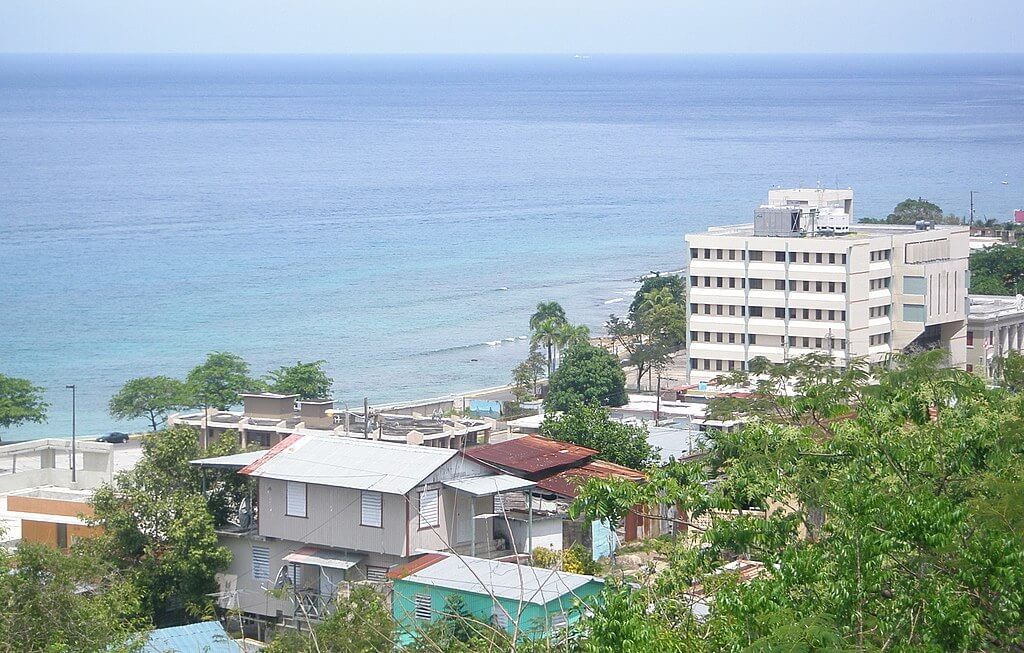New Puerto Rico Service Program Supports Country’s Future Leaders
As a commonwealth of the United States, Puerto Rico is a popular destination for Americans seeking an “international” vacation close to home. As an island in the Caribbean Sea, Puerto Rico is also an unfortunate target for destructive maritime storms. The damage of Hurricanes Maria and Irma in 2017 is still widely visible. In the farthest northwest corner of the island is Aguadilla, a coastal region of renown surfing beaches and Global Volunteers’ newest partner community. Read on to learn about the beginnings of this formative service opportunity.
Following the Spanish–American War, Puerto Rico became an territory of the United States. With the passage of the Jones-Shafroth Act in 1917, all native-born Puerto Ricans became U.S. citizens, with freedom of movement to travel back and forth to the mainland. The territory formed a government in 1950, and adopted a constitution two years later, which qualified it as a U.S. commonwealth – like Massachusetts, Pennsylvania, Virginia, and Kentucky. Interestingly, this designation has no legal meaning.

Although Puerto Rico presently has a certain amount of local autonomy, the U.S. Constitution dictates that governance of the island is retained by both the U.S. Congress and President. Further, Puerto Ricans fund the U.S. government. as American taxpayers who payroll taxes, business taxes, and estate taxes. They help pay for disaster relief and are entitled to the same response and financial help from the federal government – not as a gesture of charity.
Therefore, in referendums about statehood or independence, the vast majority of the local people clearly value some form of permanent association with the United States, although they also fiercely embrace their language and Hispanic-American culture. Part of that culture is a proud sense of self-reliance, which led to Global Volunteers’ invitation to work in partnership on important community enhancement projects in the areas of child care and education, nutrition, and basic conversational English skills.

Historically, the urban tourist areas consume a large percentage of relief and development resources, leaving rural areas with what is left over, explained Yanira Ocasio, President and CEO of the non-profit For Such a Time as This, Inc. “While the western and mountainous areas of our country are the most affected by natural disasters throughout the year, our capital of San Juan receives most of the resources, volunteers and funding – leaving the rest of the island forgotten and in great need. That’s why we’re so grateful for Global Volunteers,” she said.
Together with local leaders, Yanira recommended that Global Volunteers can best serve their rural communities in partnership with five community-based organizations touching the lives of those most vulnerable and those representing the territory’s political, economic and cultural future.



Scenes of Aguadilla. photo: Wiki Commons
“While the western and mountainous areas of our country are the most affected by natural disasters throughout the year, our capital of San Juan receives most of the resources, volunteers and funding – leaving the rest of the island forgotten and in great need. That’s why we’re so grateful for Global Volunteers.”
Yanira Ocasio, President and CEO of Such a Time as This, Inc.

Caring for Children – The Country’s Future Leaders
It’s neither an uncommon nor easy practice in many Latin American countries for parents who cannot afford to care for their children to relinquish them to orphanages to be housed and educated. Although Latin America’s extended families are close-knit, poverty can fracture even the strongest family bonds. In fact, at least 80 percent of children worldwide who live in institutions have at least one living parent, according to a study from Save the Children. According to UNICEF, of the more than 132 million children classified as orphans worldwide, only 13 million have lost both parents. A children’s home may be the only place where parents can be certain of their children’s welfare while they try to support their family. Hogar de Niños Regazo de Paz is one such place in Aguadilla – providing a safe and loving home, medical and psychological support and specialized services to some 15 children from abusive and/or impoverished families across the island. About half of the children are under age two, and half are two to eight years old.
The island’s systemic poverty rate has long exceeded that of any U.S. state, especially among children. In 2018, 43 percent of the population – fully 58 percent of children – lived in poverty, and the pandemic is expected to impoverish up to 70 percent of children.
Amidst this alarming statistic, Hogar de Niños Regazo de Paz, founded in 1995, has provided sanctuary to over 700 children. More than simply providing resident children a home, seeks to “facilitate the restoration of their individual, family and social values through good example, family coexistence and the participation in safe and healthy community activities.” Volunteers will help care for, mentor, support and encourage the children alongside caring staff.

Improving Nutrition – Feeding the Most Vulnerable
The economic consequences of the coronavirus pandemic have pushed nearly half of Puerto Ricans into hunger. According to a September 2020 survey by George Washington University, 40 percent of families reported food insecurity—a lack of consistent access to enough food—due to Covid-19. That was up from about a third before the pandemic. Twenty percent said that an adult in the household had to skip meals due to insufficient funds, compared to an already-striking 14 percent before the pandemic. The island’s chronic food insecurity even predates the recent hurricanes and pandemic. A study from 2015 showed that 22 percent of adults reported skipping meals or eating less because they could not afford food.
Sadly, federal assistance has fallen short. Puerto Ricans have been excluded from many U.S. government pandemic relief measures such as the Pandemic-EBT program, as well as the SNAP program that provides food assistance to low-income families. Those administrative roadblocks, along with on-the-ground challenges of getting food to families, have contributed to a slow pandemic rebound.
Global Volunteers will help directly address these needs in parternship with Asociación Probienestar Barrio Marías de Aguada, a food bank and thrift store in the mountainous communities of Aguadilla and Aguada. Volunteers assigned here will assist staff and volunteers in projects to extend benefits to families in great need.

Teaching English – The Language of Opportunity
While both Spanish and English are the official languages in Puerto Rico, public school instruction is conducted mainly in Spanish. English is taught as a second language and is a compulsory subject at all levels. The role of English in Puerto Rico has been controversial since the country became a territory, and national pride in the form of the Spanish language is strongly held. Today, half of Puerto Ricans speak English fluently daily or have a working knowledge of the language, according to the 2000 U.S. Census. However, only five percent speak it at home. In the remote mountainous interior, away from the tourist areas, English is rarely heard.
English is liberally used in urban media – newspapers, magazines, radio, television – as well as street signs, product labels and commercial signs. Tourism relies nearly totally on English, and those who derive all or part of their livelihoods from this industry must seek opportunities to learn the language to advance. A crucial source of English in Puerto Rico is the constant migratory flow between the continent and the island. Most of the private English language schools which liberally dot the island are out of reach for low-income residents, so frequently, Puerto Ricans will live with their English-speaking relatives on the continent and return to the island once they achieve a level of fluency to assist their career.

In teaching conversational English skills to children and adults, Global Volunteers invests in community stability and prosperity. Three community partners have requested volunteer assistance: Universidad Interamericana de Puerto Rico, a private, non-profit university with 11 locations and an enrollment of 40,000 students; Universidad de Puerto Rico en Aguadilla, a public university campus of the University of Puerto Rico founded in 1972 with an enrollment of 2,700; and Rincón Municipal Language Camp, a project facilitated by the municipality of Rincón and conducted in the mountainous region near Jaguey.
Global Volunteers’ conversational English instruction around the world takes many forms; classroom lessons, one-on-one tutoring, and language camps are the most common. Over three decades, we’ve learned that a steady stream of short-term volunteers can significantly enhance local student’s English language ability. A single volunteer may not be the one who enables a student to begin speaking in complete sentences, but volunteers who follow encourage that student to continue to study English and on to that milestone.
The Role of Volunteers
Global Volunteer’s visionary community partners are committed to hand-in-hand service and inter-cultural learning. Our early volunteer teams will be pioneers in forming this relationship on the island of Puerto Rico, and developing long-term understanding and trust – the foundation of all successful partnerships.
Early volunteers dedicate professional expertise, life experience, sincere compassion and long-held interests to an array of individual assignments that ripple through the entire community. Volunteers of all ages, backgrounds, skills and ethnicity can contribute to a Global Volunteers Puerto Rico Service Program. Inquire now to join an upcoming team.
Talk with a Volunteer Coordinator Now!





Leave a Reply
Want to join the discussion?Feel free to contribute!